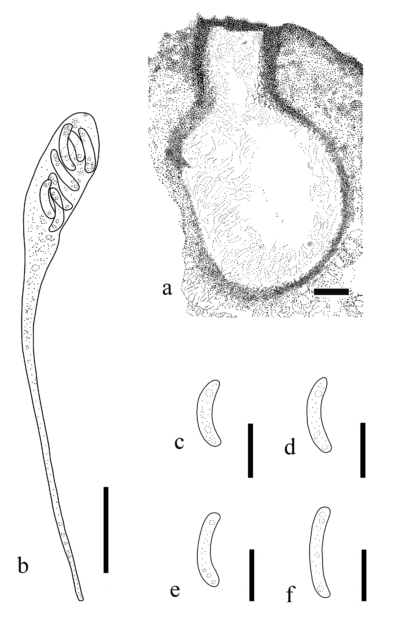Fungalpedia – Note 182, Allodiatrype
Allodiatrype Konta & K.D. Hyde
Citation when using this entry: Li et al. 2024 (in prep) – Fungalpedia. Xylariomycetidae.
Index Fungorum, Facesoffungi, MycoBank, GenBank, Fig. 1
Classification: Diatrypaceae, Xylariales, Xylariomycetidae, Sordariomycetes, Pezizomycotina, Ascomycota, Fungi
In 2020, Konta et al. (2020) proposed Allodiatrype to include A. arengae as its type species. Allodiatrype was discovered as a saprobe, thriving on the petiole of Arenga pinnata (Arecaceae) in the Phang-Nga Province of Thailand. Allodiatrype is characterized by aggregated, brown, globose to sub-globose, ostiolate ascomata; cylindrical, unitunicate, with cylindrical, with J-, 8-spored asci with apical ring; seriate, allantoid, hyaline becoming yellowish, unicellular ascospores with small fat globules at each end (Konta et al. 2020). Allodiatrype is similar to Diatrype species, with globose to subglobose ascomata, hyaline asci, ellipsoidal to cylindrical or elongate-allantoid, and aseptate ascospores. Nevertheless, Allodiatrype contains 1-10 ascomata immersed in a single stroma, with or without a black stromatic area. On the other hand, Diatrype‘s stromata, are mostly scattered across a broad region, sometimes covering the host surface (Senanayake et al. 2015). Wijayawardene et al. (2022) and Samarakoon et al. (2022) accepted Allodiatrype in Diatrypaceae, Xylariales. Species Fungorum (2023) contains a total of seven records.
Type species: Allodiatrype arengae Konta & K.D. Hyde.
Other accepted species: (Species Fungorum – search Allodiatrype)
Figure 1 – Allodiatrype arengae. a Section of the stroma. b Ascus. c–f Ascospores. Scale bars: a, b = 50 μm, c–f = 5 μm. Redrawn from Konta et al. (2020).
References
Entry by
Yanxia Li, Innovative Institute for Plant Health/ Key Laboratory of Green Prevention and Control on Fruits and Vegetables in South China, Ministry of Agriculture and Rural Affairs, Zhongkai University of Agriculture and Engineering, Guangzhou, 510225, China.
(Edited by Mingkwan Doilom, Samaneh Chaharmiri-Dokhaharani, & Achala R. Rathnayaka)
Published online 18 January 2024
